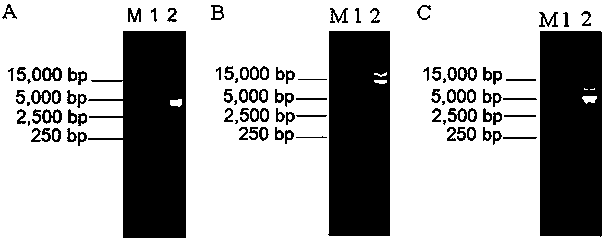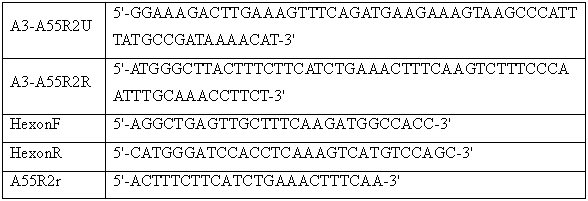Preparation method and application of human adenovirus type 3 displaying human adenovirus type 55 neutralizing epitope vaccine candidate strain
An adenovirus and candidate strain technology, which is applied in the directions of botanical equipment and methods, biochemical equipment and methods, and applications, can solve the problems of no vaccine and market launch, and achieve the effect of strengthening immunity and preventing infection
- Summary
- Abstract
- Description
- Claims
- Application Information
AI Technical Summary
Problems solved by technology
Method used
Image
Examples
Embodiment 1
[0021] Example 1: Bioinformatics analysis predicts the surface exposure region of human adenovirus type 3 hexon
[0022] The template structure of HAdv3 hexon homology modeling was searched in the Protein Data Bank (PDB) using the BLAST-P program, and Modeller 9.9 was used for homology modeling to construct a 3D model of the HAdv3 hexon protein. Select the hypervariable region sequence exposed on the surface of the capsid for the next experiment.
[0023] By analyzing the 3D model, the neutralizing epitope on the hexon of human adenovirus type 3 can be located, and the sequence exposed on the surface of the capsid that is most likely to be substituted without affecting the stability of the hexon structure can be analyzed. HVR1, HVR2, HVR4, HVR5, and HVR7 are potential neutralizing epitope regions, in which some amino acids may be substituted without affecting the stability of the hexon structure. The sequences of the two hypervariable regions are shown below, where the underli...
Embodiment 2
[0025] Embodiment 2: Construction of recombinant virus vector
[0026] The modified hexon gene was amplified by overlapping PCR (overlapping PCR). First, the DNA sequence of A55R2 (5'-TTGAAAGTTTCAGATGAAGAAAGT-3') was obtained by overlapping PCR using the HAdv3 genome as a template to replace the corresponding HVR2 of the HAdv3 hexon gene. The mutant hexon fragment of the sequence is connected to the T vector and identified by sequencing; Bam HI+ cla After double enzyme digestion, I was connected to the pBRHLR vector to obtain the shuttle vector pBRHLRA55R2. use EcoR I+ Sal I double enzyme cut shuttle vector, with vR II+ Pac The backbone plasmid pBRAd△E3GFP cut with double restriction enzymes was subjected to homologous recombination in Escherichia coli BJ5183 to obtain the recombinant plasmid pAd△E3GFPA55R2. through Bam H I / Sa l I / Hin d III enzyme digestion identification, no mutation occurred in the recombinant plasmid ( figure 1 ). The primers used are ...
Embodiment 3
[0030] Embodiment 3: Recombinant viral vector immunogenicity test
[0031] Antiserum was prepared and serum neutralization test was performed to verify the immunogenicity of the recombinant virus vector. The purified recombinant virus Ad3A55R2 was injected intramuscularly to immunize mice to obtain polyclonal serum, and then an in vitro neutralization test was performed to detect whether the antibodies produced by the recombinant virus had the ability to neutralize HAdv55 virus and HAdv3 virus in vitro.
[0032] The experimental results of the neutralization reaction of the mouse serum collected 35 days after the two immunizations are shown in Table 2, and high titers of neutralizing antibodies against HAdv55 virus and anti-HAdv3 virus can be induced.
[0033] Table 2 Neutralization titer of immune serum
[0034]
PUM
 Login to View More
Login to View More Abstract
Description
Claims
Application Information
 Login to View More
Login to View More - R&D Engineer
- R&D Manager
- IP Professional
- Industry Leading Data Capabilities
- Powerful AI technology
- Patent DNA Extraction
Browse by: Latest US Patents, China's latest patents, Technical Efficacy Thesaurus, Application Domain, Technology Topic, Popular Technical Reports.
© 2024 PatSnap. All rights reserved.Legal|Privacy policy|Modern Slavery Act Transparency Statement|Sitemap|About US| Contact US: help@patsnap.com










